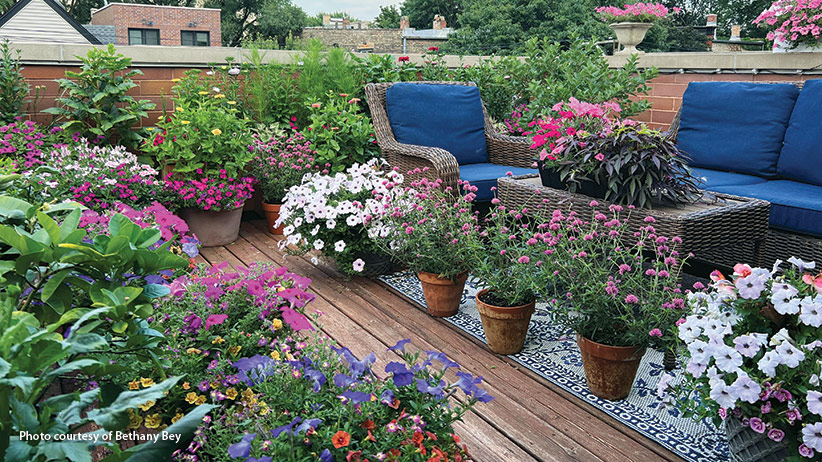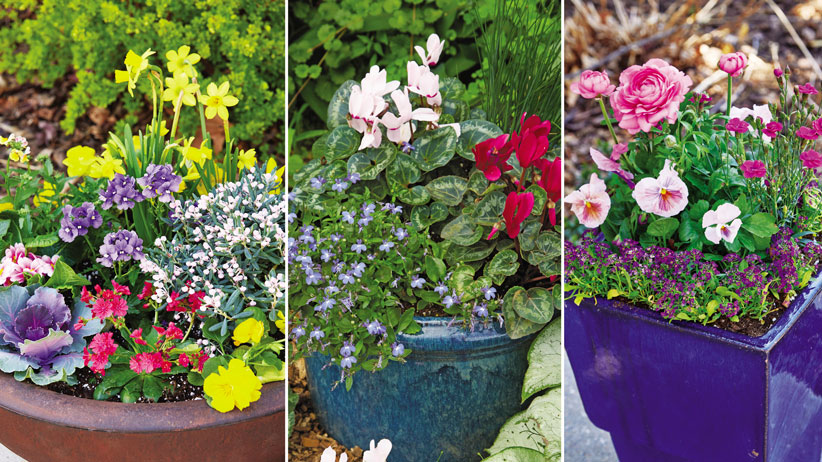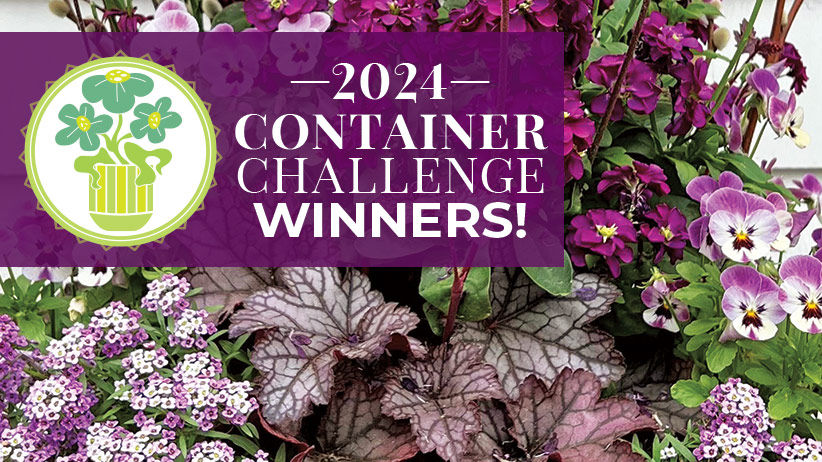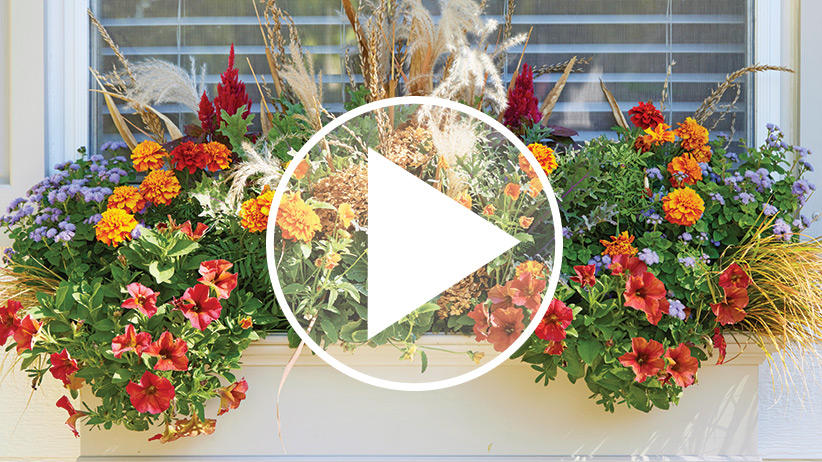The best container plants for your garden
When you're shopping at the garden center for the best container plants every spring, it's easy to become overwhelmed by aisles after aisle of options. Some of the blooming beauties you see there may last all summer while others may quickly fade. And vice versa: Some plants might not look like much in spring, but just get better and better through fall. How do you know which is which? Let us help you choose the best container plants for your garden every year!
We think the plants we chose here are some of the best container plants. Maybe they have plentiful flowers, colorful foliage or graceful trailing stems. Perhaps they’re durable plants you can count on to look good all summer long. Whatever its star quality, each of the plants below (and in the the video of our editor Kristin’s favorites above) has that extra something that every gardener can use. If you’re ready to grow great-looking containers, it all starts with the best plants. Find your new favorites here!
Our favorite plants for container gardens
Check out our top picks for reliable favorites for your best container gardens this year for both sun and shade. You won't be disappointed!
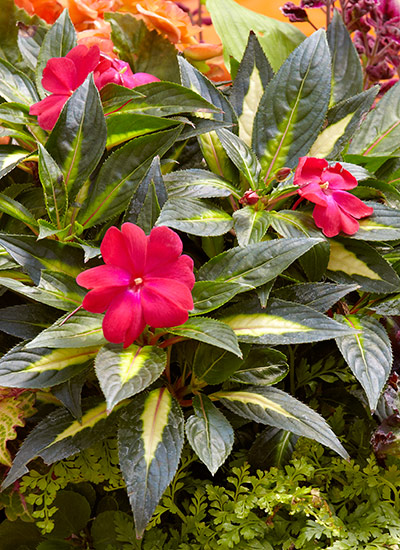
New Guinea impatiens (Impatiens hybrids)
It doesn’t get any easier than New Guinea impatiens… just plant them, keep them watered, and enjoy the show until frost finally zaps them. Most New Guinea impatiens are self-cleaning, meaning they drop their spent blooms without any deadheading from you. (Of course, if they’re in containers on your deck, you may have to sweep up fallen petals.)
Other than shade, the most important thing to remember about New Guinea impatiens is to keep them watered — their fleshy stems and leaves droop the instant the soil gets dry. Although they’ll perk back up as soon as they get more moisture, getting too dry too often will stress them, causing fewer flowers and sparse foliage.
Type Tender perennial (usually grown as an annual) Blooms Shades of lavender, purple, pink, red, orange and white from spring to frost Light Full sun to full shade Size 8 to 48 in. tall, 6 to 36 in. wide Hardiness Cold hardy in USDA zones 9 to 11
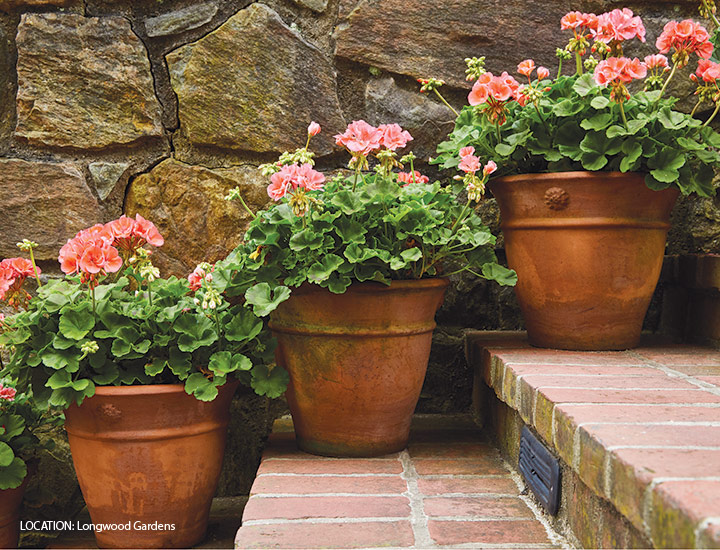
Geranium (Pelargonium hybrids)
Geraniums love the heat and don’t mind getting a bit dry, which makes them fantastic container plants. Plus they come in a wide range of flower colors. And look for tulip-, rosebud- or cactus-flowered geraniums to give a traditional planting a twist. But don’t forget the foliage! Many geraniums have a “zone” marked off on the center of each leaf.
Type Tender perennial (usually grown as annual) Blooms White, lavender, pink, orange or red blooms from spring to fall Light Full sun Size 5 to 24 in. tall and wide Hardiness Cold hardy in USDA zones 10 to 11
You Might Also Like:
The Secrets to Beautiful Geraniums
10 Best Plants for a Cut Flower Garden
Best Easy-Care Perennials
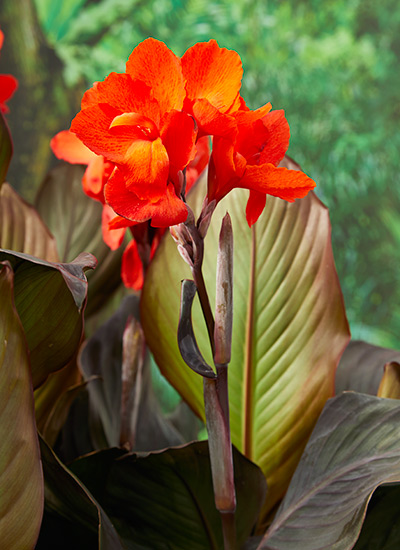
Canna (Canna spp. and hybrids)
Cannas grow bigger and better all summer, and they're economical choices for containers because even just a few rhizomes can make a large impact. If they're hardy for you, you can leave them in pots year round. If not, dig up the rhizomes after frost has killed the foliage and save them in barely damp peat moss in the basement until spring, when you can plant them outdoors again. The pretty blooms attract hummingbirds, but the large leaves are the real star. You'll find varieties with green, burgundy and even variegated foliage.
Type Tender rhizome Blooms Red, orange, yellow, pink, white or salmon in summer Size 18 to 96 in. tall, 12 to 48 in. wide Light Full sun Hardiness Cold Hardy in USDA zones 7 to 11

Payprus (Cyperus papyrus and Cyperus involucrata)
There’s something about papyrus that elevates a container from average to amazing. It must be the tufts of foliage rising from ramrod-straight stems to give a planting structure and size without stealing from the colorful components. Papyrus is perfect for height in a small container -- it stretches tall, but isn’t a space hog, staying narrow in habit. You can even pot up papyrus and move it indoors to save it for next year. It will need some light and may lose leaves, but come spring, set it outside and new sprouts will take off.
Type Tender grass Blooms Tiny yellow flowers at the ends of dramatic green tufts Size 18 to 72 in. tall and wide Light Full sun to part shade Hardiness Cold Hardy in USDA zones 10 to 11
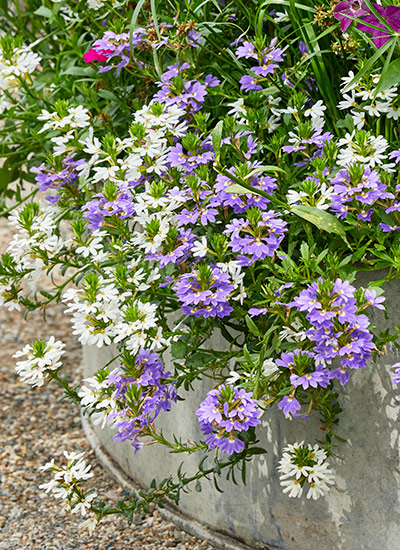
Fanflower (Scaevola aemula)
Whether you prefer white, pink or blue, like Whirlwind® series above, this is a great annual to drape over the edge of a mixed container. The common name comes from the flower petals that are arranged like fans. Drought- and heat-tolerance mean this plant will survive if you forget to water occasionally. It doesn’t need to be deadheaded, either. But to keep it tidy, shorten a few stems back a few inches every now and then to make a denser plant.
Type Tender perennial (usually grown as an annual) Blooms White, pink or blue flowers late spring through fall Light Full sun Size 6 to 18 in. tall, 16 to 24 in. wide Hardiness Cold hardy in USDA zones 10 to 11
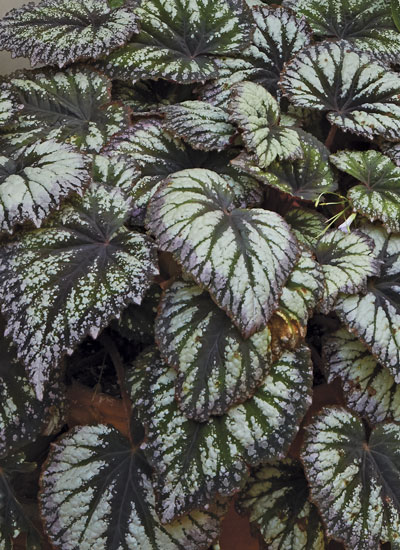
Rex begonia (Begonia rex)
A silver-leafed rex begonia like ‘Rum Painkiller’ is a great choice for perking up a shady corner. While most cultivars have other colors, such as red, mixed into their leaves, it’s the silver that makes them stars. Keep these tender perennials out of direct sunlight or the leaves will scorch.Moist, but not wet, soil is ideal. And feed them with a water-soluble organic fertilizer at half strength every two weeks.
Type Tender perennial (usually grown as annual) Blooms Not showy Light Part to full shade Size 8 to 12 in. tall and wide Hardiness Cold hardy in USDA zones 10 to 11
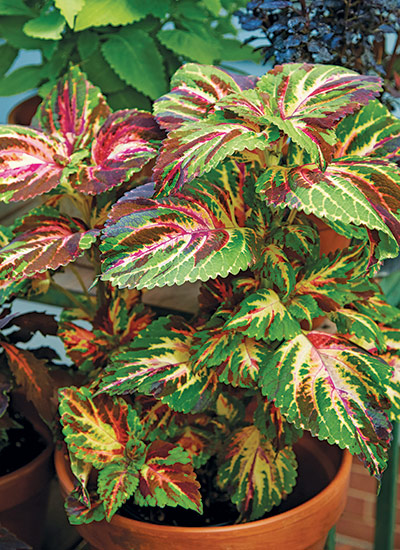
Coleus (Plectranthus hybrids)
Coleus is so versatile! Its beautiful leaves make it interesting enough to grow as a single specimen or with loads of other annuals. It's a fast grower, so start with small plants. Plant growing too tall at the end of the summer? Pinch it back. That’s all there is to it!
Type Tender perennial (usually grown as an annual) Blooms Leaves in shades of green, yellow, orange, red, pink and black, many with fancy markings; insignificant blue or white flowers all summer and fall Light Full sun to full shade Size 6 to 48 in. tall, 10 to 30 in. wide Hardiness Cold hardy in USDA zones 10 to 11
You Might Also Like:
Container Garden Collection
Heat-Tolerant Summer Flowers
How to Grow Coleus
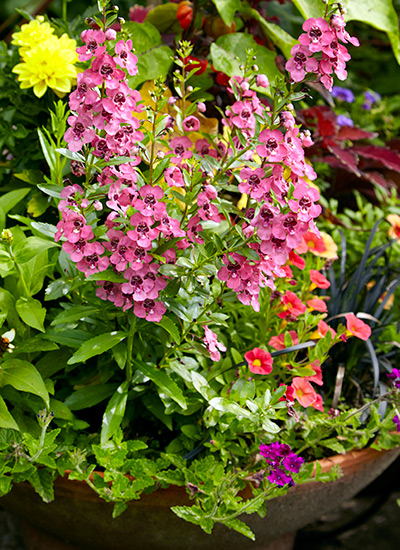
Angelonia (Angelonia angustifolia)
In a small container, the upright spikes of summer-blooming angelonia could be a focal point. But in a larger combo it's a good supporting player, too. It benefits from a weekly dose of water-soluble fertilizer. Remove spent flower stems to help promote more blooms, too.
Type Tender perennial (usually grown as an annual) Blooms White, blue, purple, pink or red late spring through frost Light Full sun Size 4 to 30 in. tall, 8 to 20 in. wide Hardiness Cold hardy in USDA zones 10 to 11
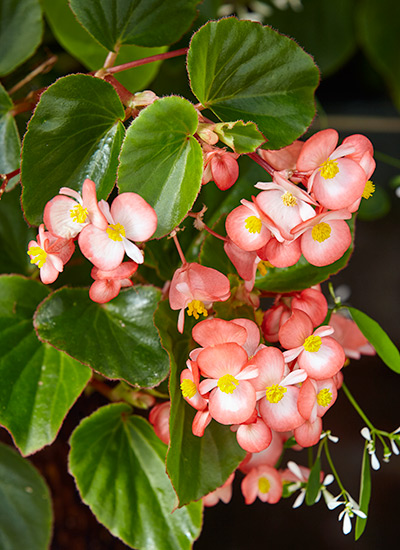
Winged begonia (Begonia hybrids)
Winged begonias are tough and drought-resistant. They're known for clean foliage and prolific blooms, too. Colors hold best in afternoon shade, but they tolerate full sun, too. This is a self-cleaning plant, so the flowers drop off as they fade — you never need to deadhead!
Type Tender perennial (usually grown as an annual) Blooms White, pink or red flowers top shiny foliage spring through frost Light Full sun to full shade Size 12 to 18 in. tall, 15 to 18 in. wide Hardiness Cold hardy in USDA zones 11 to 12

Starflower (Pentas lanceolata)
Want to attract butterflies to your garden? As soon as they find a starflower, they'll flock to it. Use this plant in the middle or back of a container. Starflower needs sun and heat to get going, so don't set one out until summer arrives. Deadhead the spent flowers for a tidy plant and more blooms.
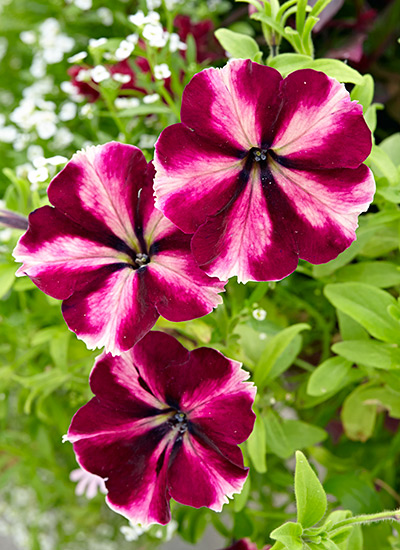
Petunia (Petunia hybrids)
Any petunia gives you lots of bang for your buck. All you have to do is choose your favorite color. Some petunias cascade over the edge of the pot while others are a bit more upright, so be sure to check the tag for size and height when you’re buying starts. You need full sun to keep these annuals blooming and going strong. And every few weeks, snip off a few stems here and there to stimulate side branches — and more flowers.
Type Tender perennial (usually grown as an annual) Blooms Many colors, spring through frost Light Full sun Size 4 to 24 in. tall, 8 to 96 in. and wide Hardiness Cold hardy in USDA zones 10 to 11
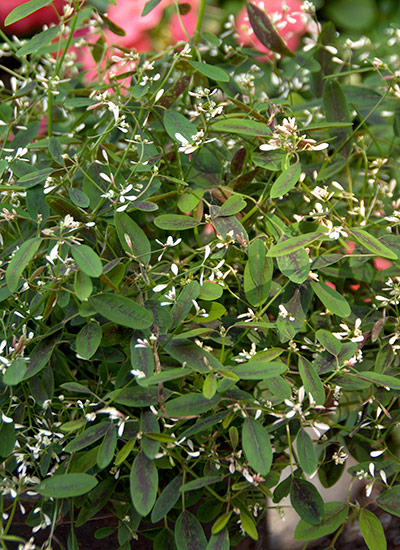
Euphorbia (Euphorbia hypericifolia)
If you like baby’s breath as a filler in your bouquets, you’ll love this annual euphorbia in your conatiner garden plantings. Diamond Frost® is the standard white. But now there is Breathless™ Blush, above, with burgundy-speckled leaves and pale pink flowers. Wet soil can be fatal, so let plants dry out between waterings. As you plant, make sure all of the companions in your container like the same conditions.
Type Tender perennial (usually grown as an annual) Blooms White or pink flowers late spring through fall Light Full sun to part shade Size 12 to 18 in. tall and wide Hardiness Cold hardy in USDA zones 10 to 12
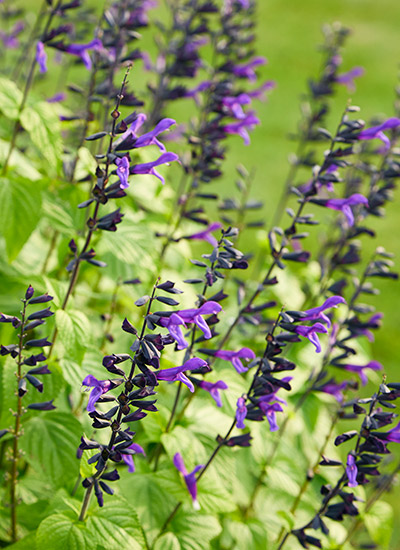
Late-season sages (Salvia spp. and hybrids)
When tender sages are packaged in 4-inch pots and lined up along the greenhouse benches at the nursery in spring, it’s difficult to believe that their handful of compact bloom spikes daintily dancing above tidy foliage could make an impact on the garden come fall. But these plants get better all season and keep going despite dropping temps!
What makes these plants so lovable? They’re problem-solvers for tricky situations: They tolerate drought, handle high heat, don’t mind humidity, and deer don’t usually eat them. Even better, pollinators love them — especially hummingbirds.
Type Perennial Blooms Red, pink, orange, purple, blue or white tubular flowers on long stems from summer through fall Size 10 to 48 in. tall, 8 to 60 in. wide Light Full sun Hardiness Cold Hardy in USDA zones 7 to 11
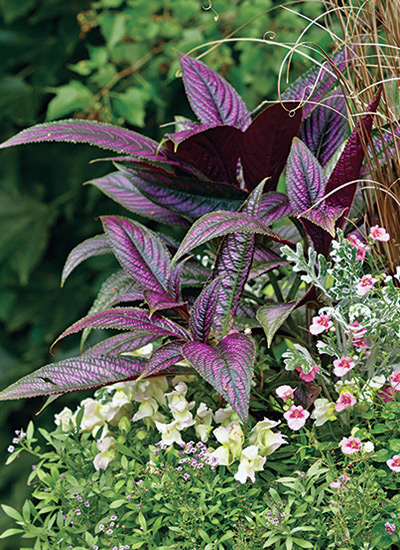
Persian shield (Strobilanthes dyeriana)
Slightly shiny purple foliage make a great contrast or backdrop for plants with bright-colored flowers. The foliage color is best in part shade. Persian shield also has pale blue blossoms in late summer or fall — you can leave them or pinch them off. Don't let the soil get too dry or it will drop leaves. Persian shield overwinters nicely indoors as a houseplant.
Type Tender perennial (usually grown as an annual) Blooms Iridescent purple leaves; insignificant blue flowers in late summer or fall Light Full sun to full shade Size 18 to 36 in. tall and wide Hardiness Cold hardy in USDA zones 9 to 11
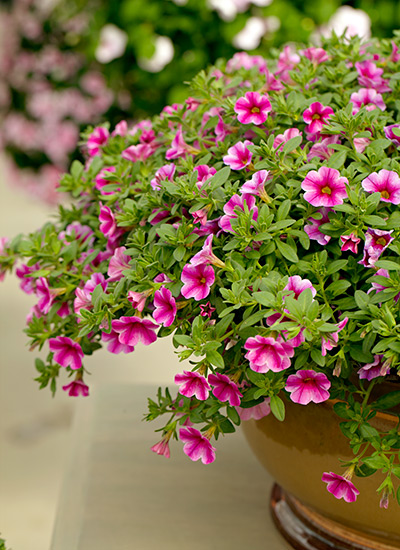
Calibrachoa (Calibrachoa hybrids)
Calibrachoa’s trailing habit makes it ideal for hanging baskets. And a single plant, can cover a small container. Even though the billowy flowers slow during the heat of summer, they come barreling back as the weather cools. With consistent moisture, they’ll bloom until frost or the days get short.
Type Tender perennial (usually grown as annual) Blooms Flowers in shades of blue, violet, white, yellow, red, orange, peach, bronze or pink from spring through fall Light Full sun to part shade Size 6 to 10 in. tall, 18 to 24 in. wide Hardiness Cold hardy in USDA zones 9 to 11
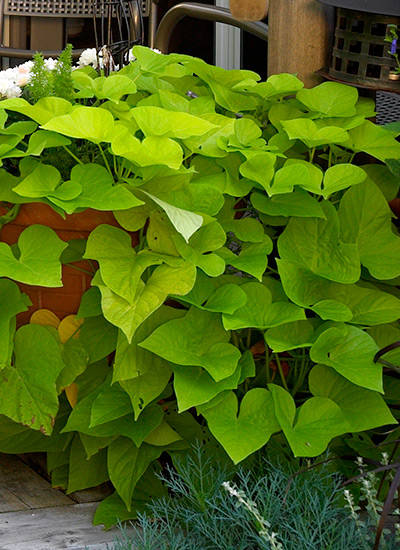
Sweet potato vine (Ipomoea batatas)
Cascades of burgundy, brown, gold or variegated leaves make this tender perennial popular. Occasionally snip the tips of the stems back a couple of inches to keep the vine under control. It grows quickly, so you can start with a small plant and reap big rewards in no time.
Type Tender perennial (usually grown as an annual) Blooms Burgundy, brown, gold, green and variegated leaves spring through fall Light Full sun to part shade Size 4 to 12 in. tall, 18 to 72 in. wide Hardiness Cold hardy in USDA zones 8 to 11
You Might Also Like:
How to Design Beautiful Garden Planters
Container Plants You Don't Have to Deadhead
Best Foliage Plants for Containers
Colorful Windowbox Plantings








